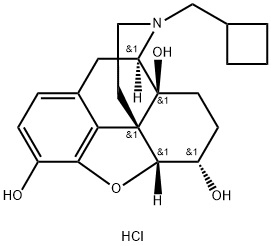23277-43-2

Product Name:
NALBUPHINE HYDROCHLORIDE
Formula:
C21H28ClNO4
Synonyms:
17-(Cyclobutylmethyl)-4,5-epoxymorphinan-3,6,14-triol;17-(Cyclobutylmethyl)-4,5-epoxymorphinan-3,6,14-triol hydrochloride hydrate
Inquiry
CHEMICAL AND PHYSICAL PROPERTIES
| Collision Cross Section | 180.8 Ų [M+H]+ [CCS Type: TW, Method: calibrated with polyalanine and drug standards] |
|---|
SAFETY INFORMATION
| Signal word | Danger |
|---|---|
| Pictogram(s) |
 Skull and Crossbones Acute Toxicity GHS06 |
| Precautionary Statement Codes |
P260:Do not breathe dust/fume/gas/mist/vapours/spray. P262:Do not get in eyes, on skin, or on clothing. P264:Wash hands thoroughly after handling. P264:Wash skin thouroughly after handling. P280:Wear protective gloves/protective clothing/eye protection/face protection. |
COMPUTED DESCRIPTORS
| Molecular Weight | 393.9 g/mol |
|---|---|
| Hydrogen Bond Donor Count | 4 |
| Hydrogen Bond Acceptor Count | 5 |
| Rotatable Bond Count | 2 |
| Exact Mass | 393.1706861 g/mol |
| Monoisotopic Mass | 393.1706861 g/mol |
| Topological Polar Surface Area | 73.2 Ų |
| Heavy Atom Count | 27 |
| Formal Charge | 0 |
| Complexity | 597 |
| Isotope Atom Count | 0 |
| Defined Atom Stereocenter Count | 5 |
| Undefined Atom Stereocenter Count | 0 |
| Defined Bond Stereocenter Count | 0 |
| Undefined Bond Stereocenter Count | 0 |
| Covalently-Bonded Unit Count | 2 |
| Compound Is Canonicalized | Yes |
PRODUCT INTRODUCTION
description
Nalbuphine Hydrochloride is the hydrochloride salt form of nalbuphine, a synthetic phenanthrene opioid with opiate agonist and antagonist effects, used to treat moderate to severe pain and provide preoperative and postoperative analgesia and sedation. Nalbuphine hydrochloride binds to kappa-, mu- and delta-opioid receptors but not to sigma-opioid receptors. This opioid exerts its analgesic actions primarily through kappa-opioid-receptor agonism and partially through mu-opioid receptor agonism.
